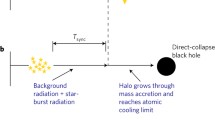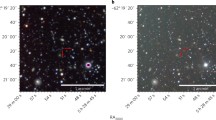Abstract
We study the evolution of molecular clouds under the influence of ionizing radiation. We propose that the Pipe Nebula is an HII region shell swept up by the B2 IV β Cephei star θ Ophiuchi. After reviewing the recent observations, we perform a series of analytical calculations. We are able to show that the current size, mass and pressure of the region can be explained in this scenario. The Pipe Nebula can be best described by a three phase medium in pressure equilibrium. The pressure support is provided by the ionized gas and mediated by an atomic component to confine the cores at the observed current pressure. We then present simulations on the future evolution as soon as the massive star explodes in a supernova. We show that a surviving core at the border of the HII-region (D = 5 pc) is getting enriched sufficiently with supernova material and is triggered into collapse fast enough to be consistent with the tight constraints put by meteoritic data of e.g.26Al on the formation of our Solar System. We therefore propose that the formation of the Solar System was triggered by the shock wave of a type IIa supernova interacting with surviving cold structures similar to the Pillars of Creation at the border of HII-regions.
Access provided by Autonomous University of Puebla. Download conference paper PDF
Similar content being viewed by others
Keywords
These keywords were added by machine and not by the authors. This process is experimental and the keywords may be updated as the learning algorithm improves.
1 The Pipe Nebula
The Pipe Nebula is a nearby (D ≈ 130 pc, [1]) molecular cloud region. Its total spatial extend is roughly 14 × 3 pc. Due to its relative proximity, it provides an ideal testbed to observe molecular cloud core formation [2]. As star formation only occurs in one tip (B59), it is often considered the model case for isolated star formation. Here, we investigate the role of the B2 IV β Cephei star θ Ophiuchi (HD 157056), located at a projected distance of about 3 pc from the Pipe Nebula, in the formation and evolution of the Pipe Nebula.
The B-type star is going to ionize the surrounding, thereby increasing its temperature. As soon as the heated gas reacts to its change in pressure, an approximately isothermal shock is driven into the surrounding medium. Under the assumption of a thin shock, the time evolution of the radius is given as
R s is the Stroemgren radius, a s,hot is the sound speed of the hot, ionized gas.
In the following, we assume the cold gas to be at T cold = 10 K with a mean molecular weight of μ cold = 1. 37 We test three models A, B and C, corresponding to initial number densities n 0 in the cold surrounding of 1 × 103, 5 × 103 and 1 × 104 cm−3, respectively. We parametrize θ Oph A as a black body with a temperature of T eff = 22, 590 K and a luminosity of \(\mathrm{log}(L/L_{\odot }) = 3.75\).
Time evolution of the HII-region for the three different cases. Solid lines: classical (spherical) HII-region, dashed: blister-type HII-region. The lines are continued dotted once the shock has reached equilibrium with the ambient surrounding. Dotted horizontal lines: current day observational values. Left panel: radius of the shell. Center: swept up mass in a Pipe Nebula sized region. Right: pressure in the hot, ionized gas (Fig. 2 from [3])
The results are shown in Fig. 1. As it can be directly seen, the current observations can be readily explained. Concerning the current state, our models indicate a three-phase medium in pressure equilibrium. The pressure is supplied by the hot, ionized gas (T = 5, 000 K and \(n_{0} = 8\,\mathrm{{cm}}^{-3}\)) and is mediated by a warm, atomic component (T = 100 K and \(n_{\mathrm{atomic}} = 774\,\mathrm{{cm}}^{-3}\)) to the cold cores (T = 10 K and \(n_{\mathrm{atomic}} = 7 \times 1{0}^{3}\,\mathrm{{cm}}^{-3}\)). For a more detailed discussion see [3].
2 The Formation of the Solar System
The time evolution of case I. Color coded is the density at t = 0 kyr, t = 4. 16 kyr and t = 8. 33 kyr. The length scale is given in units of the radius of the initial cold core (R 0 = 0. 21 pc) (Fig. 2 from [4])
We then go on to investigate the further evolution, as soon as the massive star explodes in a supernova. This is in particular interesting in the context of the formation of the Solar System. The time-scale for the formation events of our Solar System can be derived from the decay products of radioactive elements found in meteorites. Short lived radionuclides (SLRs) within calcium-aluminium-rich inclusions (CAIs) in primitive chondrites, such as26Al, can be employed as high-precision chronometers due to their short half-lives. Various measurements of different CAIs by several research groups have not only confirmed the canonical ratio of (5. 23 ± 0. 13) × 10−5 for26Al, but also established a very small spread. This spread corresponds to an age range of less than ≃ 20 kyr [5]. Thus, the challenge posed is how to enrich the Solar System with enough26Al and, in addition, trigger it into collapse within a fraction of the free-fall time (t ff ≈ 100 kyr).
We set up an molecular cloud core in isolation, which is going to be hit by a Sedov-Taylor type supernova blast wave. The simulations are performed with the numerical code COSMOS [6]. Figure 2 shows the time evolution of the density in this simulation. The shock wave is propagating from the bottom to the top. As it can be clearly seen, the shock wave encompasses the cold core rapidly. After t = 8. 33 kyr the central region is already at a very high density (\(\rho _{\mathrm{max}} = 3 \times 1{0}^{-15}\,\mathrm{g}\,\mathrm{{cm}}^{-3}\)). The mass in this region below a temperature of 20 K is M core ≃ 0. 13 M⊙. A closer look at the field tracing the supernova-enriched gas shows that the core region gets sufficiently enriched within this short time to explain the abundances observed in CAIs. For a more detailed description of the initial conditions and numerical methods see [4].
3 Conclusions
The scenario of θ Oph swiping up the Pipe Nebula presented can successfully explain the observed morphology of the Pipe Nebula. This includes the diffuse component as well as the current width, mass and size of the Nebula. More importantly, the pressure to confine the cores can be supplied. Especially the pressure of the cores is otherwise puzzling. Up to now, the only possible explanation for this confinement was the self-gravity of the cloud. This is highly unlikely, as the cores in a self-gravitating system are the first instances to react to the collapse and therefore should be bound, whereas most of the cores are observed to be unbound.
In addition, we show that a cold clump of 10 M⊙ at a distance of 5 pc can be sufficiently enriched in26Al and triggered into collapse fast enough for a range of different metallicities and progenitor masses. We envision an environment for the birth place of the Solar System 4. 567 Gyr ago similar to the situation of the pillars in M16 nowadays, where molecular cloud cores adjacent to an HII region will be hit by a supernova explosion in the future. We show that the triggered collapse and formation of the Solar System as well as the required enrichment with radioactive26Al are possible in this scenario.
References
M. Lombardi, J. Alves, C.J. Lada, A&A 454, 781 (2006). DOI 10.1051/0004-6361:20042474
C.J. Lada, A.A. Muench, J. Rathborne, J.F. Alves, M. Lombardi, ApJ 672, 410 (2008).
M. Gritschneder, D.N.C. Lin, ApJL 754, L13 (2012).
M. Gritschneder, D.N.C. Lin, S.D. Murray, Q.Z. Yin, M.N. Gong, ApJ 745, 22 (2012).
B. Jacobsen, Q. Yin, F. Moynier, Y. Amelin, A.N. Krot, K. Nagashima, I.D. Hutcheon, H. Palme, Earth and Planetary Science Letters 272, 353 (2008).
P. Anninos, P.C. Fragile, S.D. Murray, ApJS 147, 177 (2003).
Acknowledgements
M.G. acknowledges funding by the Alexander von Humboldt Foundation in form of a Feodor-Lynen Fellowship and by the China National Postdoc Fund Grant No. 20100470108 and the National Science Foundation of China Grant No. 11003001. D.N.C.L. acknowledges funding by the NASA grant NNX08AL41G.
Author information
Authors and Affiliations
Corresponding author
Editor information
Editors and Affiliations
Rights and permissions
Copyright information
© 2014 Springer International Publishing Switzerland
About this paper
Cite this paper
Gritschneder, M., Lin, D.N.C. (2014). Triggering Star Formation: From the Pillars of Creation to the Formation of Our Solar System. In: Stamatellos, D., Goodwin, S., Ward-Thompson, D. (eds) The Labyrinth of Star Formation. Astrophysics and Space Science Proceedings, vol 36. Springer, Cham. https://doi.org/10.1007/978-3-319-03041-8_35
Download citation
DOI: https://doi.org/10.1007/978-3-319-03041-8_35
Published:
Publisher Name: Springer, Cham
Print ISBN: 978-3-319-03040-1
Online ISBN: 978-3-319-03041-8
eBook Packages: Physics and AstronomyPhysics and Astronomy (R0)






